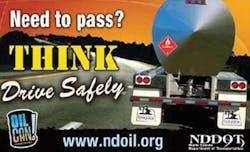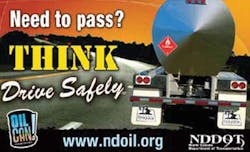Trucking the Bakken
PAULA DITTRICK
Senior Staff Writer
The North Dakota Petroleum Council worked jointly with state officials to develop a Drive Safely public service campaign.
What's an oil boom look like? Years ago, I would have envisioned drilling rigs and roughnecks. That image remains true, but a recent trip to the Bakken formation in North Dakota expanded my thoughts about a boom to include trucks, thousands of trucks, going to and from the oil fields.
The busiest intersection in the state for oil-related truck and large machinery traffic could well be US Highway 2 and North Dakota 8 on the outskirts of Stanley in Mountrail County. A seemingly continuous flow of truck traffic is taking a toll on the state and local roads.
The North Dakota Department of Transportation (NDDOT) web site warns motorists about areas of broken concrete on North Dakota 8 from Stanley to Bowbells. The state's fiscal planners are calculating the cost of wear and tear on the roads.
North Dakota Gov. Jack Dalrymple recommended the state spend $229 million repairing and improving state roads in the oil-producing region during 2 years, including $142 million in road aid for counties and townships.
During a Bakken Investor Conference in Minot during June, North Dakota State Rep. Vicky Steiner said more than 10,000 trucks associated with the oil and gas industry traverse state and county roads daily. Steiner is executive director of the North Dakota Association of Oil & Gas Producing Counties, an organization representing 17 western counties where Bakken activity is concentrated.
Maintenance costs
North Dakota State University's Upper Great Plains Transportation Institute published a study estimating at least $907 million will be needed over 20 years to rebuild or maintain roads that the institute identified as carrying oil industry traffic in western North Dakota.
The Upper Great Plains researchers based their calculations on 5,200 active wells in North Dakota at the time. Researchers took into account a forecast from the North Dakota Oil & Gas Commission that more than 21,000 new oil wells could be drilled in western North Dakota during the next 20 years.
It's estimated the average well requires 2,024 truck trips from the time the well is spudded to when it's completed. This includes 600 truck trips to haul water, 100 truck trips for hydraulic fracturing tanks, and 80 truckloads each of sand and gravel. Trucks also transport rig equipment, drilling mud, chemicals, cement, and pipe.
Pending completion of more pipelines and gathering systems, trucks currently transport much of the oil from the fields. About 200,000 b/d of oil is hauled by truck, which Steiner said translates into 1,000 trips/day. Some Bakken crude oil moves by pipeline or rail.
Driving safety is being addressed through a public service campaign cosponsored by the North Dakota Petroleum Council. The driving safety campaign is part of Oil Can!, an outreach and education effort on behalf of the council's member oil and gas companies, said Ron Ness, council president.
Safety emphasis
NDDOT and the petroleum council together created a "Drive Safely" public service campaign. Images resembling the one on this page were put on billboards along five highways in western North Dakota.
"With more vehicles on roads across western North Dakota, the importance of driving safely has multiplied exponentially, especially because the majority of these vehicles are far larger than pick-ups and cars," Ness said of trucks and large machinery traffic.
More Oil & Gas Journal Current Issue Articles
More Oil & Gas Journal Archives Issue Articles
View Oil and Gas Articles on PennEnergy.com

